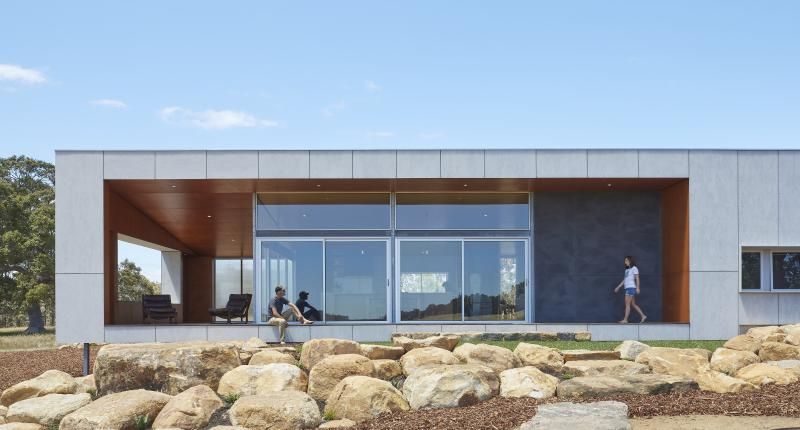
- A premium on privacy, with the home barely visible from the road and resembles a shed
- The beautifully brings the outdoors in, with many of the views well framed
- Paddock House is simple and functional
Architect Paul O’Reilly’s Paddock House was built for his sister and her young family.
The design is simple and functional. While not limited by space, the family home is efficient in its layout and orientation, making the most of what the property has to offer.
The home is designed to be incredibly private, and not stand out from the landscape of the property. Paddock House is nestled just below the crest of the property’s high point and is only seen by those looking for it. While the property is barely visible from the road outside, when catching a glimpse, it seems like an unassuming shed.
Being situated on a slight slope, the design also makes the most of valley views down towards a tributary of the Margaret River.
Bringing the outdoors in
From the outset, it was important to bring the outside in and to establish close contact with nature. Expansive views of the surrounding, seasonally changing landscape are framed, encouraging both light and the outside to spill into the interior.
An outdoor room on the eastern side of the house is shielded from the environment by a large, operable polycarbonate panel, that can open to create an unobstructed link with the environment. When lit up at night, the translucence of the closed panel emits a warmth onto the surrounding area. Used for a multitude of functions across all seasons, this room acts as the heart of the home, the pivot point of daily life.
Including three bedrooms and an office, the design was driven by simplicity and sustainability. Views are maintained throughout the house through the inclusion of an east-to-west passageway which extends from the living areas and outdoor room on the eastern side to the private areas of the houses on the western side.
The master bedroom frames views to the southwest, capturing views of jarrah and marri trees which are typical of the area. Clever use is made of the loft space at the high end of the skillion roof which has a ceiling height of up to 3.8 metres.
In the children’s bedrooms, beds are raised on platforms creating an extra space below for day-to-day activities.
“In designing Paddock House, I sought to elevate the experience of daily living, wanting to cater to my sister’s young and busy family. Although its form is simple, it will adapt to the changing needs of the children as they grow.”
Paul O’Reilly, Architect
Paddock House’s design seeks to minimise its environmental footprint. With a predominantly northern orientation, Paul has made intelligent use of eaves on the northern elevation which shields the harsh summer sun while inviting the warm winter sun in.
The placement of windows and doors enables efficient cross-ventilation, making use of the predominantly easterly and westerly breezes in summer. The concrete blocks and the tile-lined concrete floor provide thermal mass, capturing and storing warmth in the cooler winter months and keeping the house cool in summer.
The house is not connected to scheme water, so water catchment and a water-efficient garden was fundamental to its design. Rainwater runs freely over the skillion roof and is captured in large tanks. A septic system enables grey-water recycling and the house shares a 4.5KW solar array with an existing house on the property, which is the maximum allowed to be fed into the property’s 3kVa transformer.
“The house is lived in and loved,” says Paul. “Functionally, it works and, from a design point of view, it minimises its environmental impact. This was important not only to me, as an architect, but my sister also.”
~~
Written by Cassandra Simpson. Photography by Douglas Mark Black.
This story was originally published in The Architect magazine, an official publication of the Australian Institute of Architects. It has been edited for republication by The Property Tribune.
The Property Tribune thanks the Australian Institute of Architects for the opportunity to republish the work, and shine a light on Australian architecture.

























